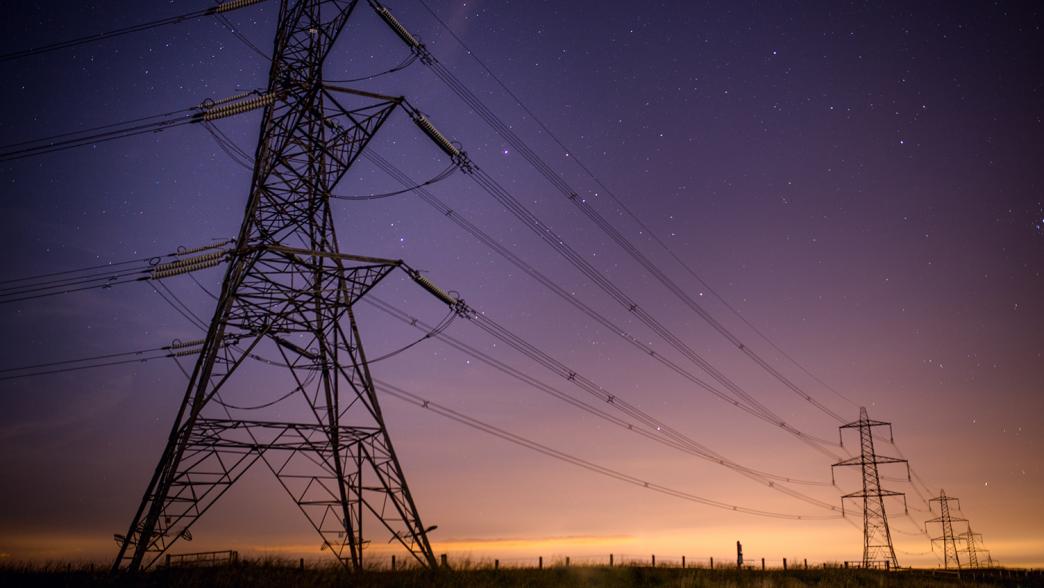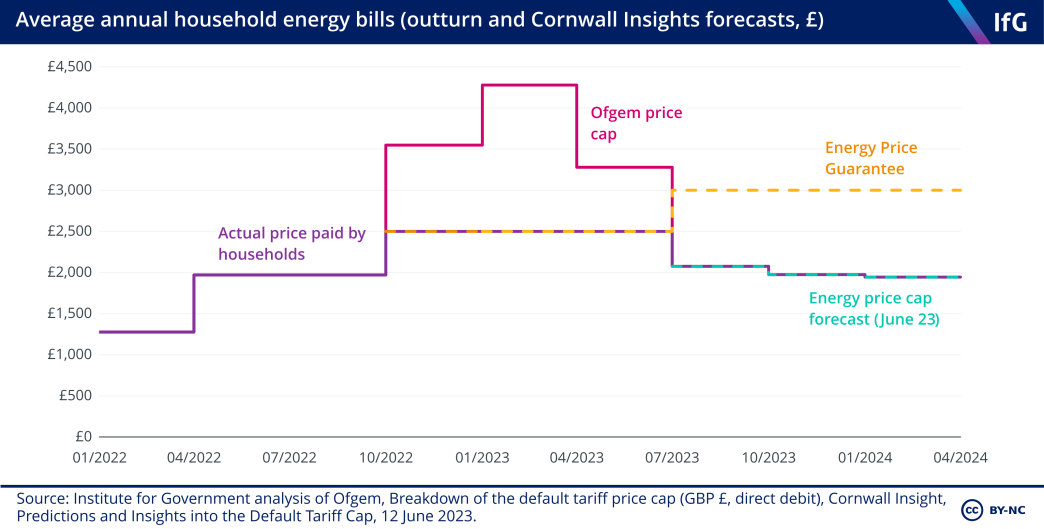Energy price cap
Amid soaring energy bills, we explain what the Ofgem price cap is and how it's calculated.

What is the Ofgem price cap?
The energy price cap is the maximum price that energy firms are allowed to charge households on their “default tariffs” 31 These are the basic tariffs that energy suppliers offer to customers where the price per unit can vary. Customers are typically on default tariffs if they have not agreed a fixed-term contract with their supplier, if a fixed-term tariff expires and they haven’t agreed a new one, or if a customer moves to a new supplier when theirs exits the market. and is set by Ofgem (the Office for Gas and Electricity Markets, Great Britain’s independent energy regulator).
The cap actually restricts the unit price for energy – that is, the maximum amount that suppliers can charge for electricity and gas (both measured in kilowatt hours – kWh). But in public communications, Ofgem expresses the cap in terms of the amount that a household with ‘typical consumption’ would pay each year. The cap in place from July 2023 means an energy bill for the typical household of £2,074 per year.
Between October 2022 and June 2023, in the face of soaring energy bills, the ’Energy Price Guarantee’ limited prices for typical households to £2,500 per year (described in more detail below). Had this not been in place, the average household would have risen to a peak of £4,279 between January and March 2023, according to the Ofgem cap.
Because energy prices will fall below the threshold for the Energy Price Guarantee (to £2,074 per year) between July and September 2023, the scheme will no longer pay out. However, the policy remains in place (with a higher threshold of £3,000) until March 2024 so, should prices rise significantly again, households will receive support from the policy again.

There is actually no limit on the total bill paid by individual households under either the Ofgem price cap or the government’s Energy Price Guarantee. Instead, the cap is applied both to the daily standing charge (the amount paid each day regardless of energy use) and on charges for each unit of energy used (in kilowatt-hours, kWh). Because the cap applies to the unit price of energy, those using more or less energy than average may have a much higher or lower bill than the ‘typical’ yearly amount. People with energy-intensive medical equipment or poor insulation, for example, require much more energy, while those in detached houses can expect to pay almost double those in flats. 32 Energy Saving Trust, What is the energy price cap?, 26 August 2022, https://energysavingtrust.org.uk/what-is-the-energy-price-cap
Other important features not captured in the headline figure are:
- separate price caps for gas and electricity (though these tend to be highly correlated because the price of gas sets the price for electricity).
- it was previously the case that customers with prepayment meters paid more than those paying by direct debit. At the 2023 budget, however, Jeremy Hunt announced that this ‘prepayment premium’ would be brought to an end.
- small variations in the cap across regions.
How are energy costs distributed through the year?
People use more energy in winter than summer to heat homes. For customers paying by direct debit, energy firms try to smooth out monthly variation in their bills, meaning they effectively pay more than the amount of energy they use in the summer, building up a surplus that is then drawn down over the winter. 43 Which?, Explained: why are energy direct debits so high? And what you can do about it, 31 March 2022, www.which.co.uk/news/article/explained-why-are-energy-direct-debits-so-high-auAf66F6gQnb But customers on prepayment meters or standard credit pay for the energy they use each month, meaning their bills are higher in the winter than in the summer.
Who is not covered by the Ofgem price cap?
Some groups are not (fully) protected by the cap, including:
- those who don’t have conventional gas and electricity supplies – for example, those who use oil for heating, live in park homes, or are on heat networks
- households that are on fixed tariffs, meaning they agree a certain price per unit of energy with their supplier (often for a year or two)
- households in Northern Ireland, where energy suppliers are not regulated by Ofgem
- all businesses, charities and public services.
How is the cap calculated and why has it been increasing?
Ofgem calculates the cap based on the total costs faced by energy retailers plus an allowance for 1.9% profit on top. 44 Forbes, Energy Price Cap And Govt Price Guarantee – The Latest State Of Play, 24 November 2022, www.forbes.com/uk/advisor/energy/energy-price-caps/ As well as the costs suppliers face in buying energy on the wholesale market, the price cap also includes costs of network maintenance, regular operation and those related to government environmental schemes (green levies).
The cap was set every six months but, since October 2022, is now be calculated every three months.
Because retailers can and often do buy energy on forward markets for delivery in the months/years ahead (rather than in the days/hours before it is needed), the cap in a given three month period is announced around a month before the cap takes hold, using the prices on the forward market in the three months preceding the announcement. For example, the cap for October – December 2022 was announced in August and determined using the prices observed on the forward market between May and August.
The cap has been increasing over the past year mainly because the wholesale cost of energy has risen – some non-wholesale costs have risen but their contribution to the overall cap is marginal in comparison to wholesale costs. 45 A notable exception is Ofgem’s decision to pass on some of the cost of supplier failures onto increased standing charges. 46 Capstick A, Energy price cap standing charges will continue to include the cost of supplier failures, as Ofgem rules out changes, Money Saving Expert, 18 August 2022, www.moneysavingexpert.com/news/2022/08/ofgem-rules-out-shifting-the-costs-of-supplier-failure-out-of-th/ #
How has the cap changed over time?
The cap was introduced on all variable tariffs in 2019 (after initially being on prepayment tariffs since 2017) because energy companies were charging people too much. 47 Capstick A, What is the energy price cap?, Money Saving Expert, 24 January 2023, www.moneysavingexpert.com/utilities/what-is-the-energy-price-cap/ Many customers would not readily switch energy providers, and so energy companies pushed prices up and some customers ended up paying a ‘loyalty penalty’. The cap acted as a price ceiling to protect those who faced this loyalty penalty, saving customers on default tariffs around £75-100 per year in 2019/20, according to BEIS. 48 Department for Business, Energy & Industrial Strategy and The Rt Hon Sir Alok Sharma KCMG MP, 11 million households to make savings as government extends cap on energy bills, press release, 20 October 2020, www.gov.uk/government/news/11-million-households-to-make-savings-as-government-extends-cap-on-energy-bills
But when wholesale energy prices become highly volatile, the cap acted for a time as a price floor on the market (with many fixed rate tariffs above the capped tariff). 49 Lewis M, On a FIXED energy deal? Will you pay less under the new 1 Oct price guarantee?, Money Saving Expert, 17 October 2022, www.moneysavingexpert.com/utilities/-are-there-any-cheap--fixed-energy-deals-currently-worth-it--/ The cap mainly functioned to reduce volatility and delay rises in retail energy prices. It does not, however, protect consumers from price rises in the longer-term, as the cap will increase after each review if wholesale costs for suppliers have increased (hence why consumers could only be protected from sustained price rises through government intervention).
The way that the cap works, combined with what the House of Commons Public Accounts Committee has described as “Ofgem’s failure to effectively regulate the… market”, 50 Public Accounts Committee, PAC: Ofgem failures “come at considerable cost to energy billpayers”, 13 November 2022, https://committees.parliament.uk/committee/127/public-accounts-committee/news/174285/pac-ofgem-failures-come-at-considerable-cost-to-energy-billpayer… caused some energy suppliers to go bust. Ofgem increased the cap in October 2021, for example, based on the costs for firms who bought energy on forward markets in the spring and summer before. 51 Capstick A, Energy direct debits help, Money Saving Expert, 9 January 2023, www.moneysavingexpert.com/utilities/lower-energy-direct-debits; Capstick A and Caffell G, Prepaid gas and electricity, Money Saving Expert, 1 February 2023, www.moneysavingexpert.com/utilities/switch-prepaid-gas-electricity But wholesale energy costs increased rapidly after Ofgem set the cap. This meant firms who had not already bought energy for that period faced much higher costs, but were not allowed to sell at a higher price due to the cap. Sixteen energy firms collapsed before the end of 2021 and Ofgem moved to setting the cap every three months to be more responsive to rapid price changes. 52 Citizens Advice, Check who's taken over your energy supply, www.citizensadvice.org.uk/consumer/energy/energy-supply/problems-with-your-energy-supply/check-whos-taken-over-your-energy-supply; Ofgem, Ofgem confirms changes to the price cap methodology and frequency ahead of new rate to be announced later this month, press release, 4 August 2022, www.ofgem.gov.uk/publications/ofgem-confirms-changes-price-cap-methodology-and-frequency-ahead-new-rate-be-announced-later-month
What is the energy price guarantee?
Two days after becoming prime minister, Liz Truss announced an ‘energy price guarantee’ (EPG).
55
Prime Minister's Office, 10 Downing Street, Department for Business, Energy & Industrial Strategy, and The Rt Hon Elizabeth Truss MP,
Government announces Energy Price Guarantee for families and businesses while urgently taking action to reform broken energy market, press release, 8 September 2022, www.gov.uk/government/news/government-announces-energy-price-guarantee-for-families-and-businesses-while-urgently-taking-action-to-reform-broken-ener…
Initially planned to be in place for two years, under the policy a typical household pay £2,500 annually (though, like the Ofgem cap, this is actually a cap on unit energy costs, rather than an actual limit on households’ bills).
- Shortly after entering office as chancellor in October 2022, Jeremy Hunt then said that the EPG would only be in place for six months rather than two years, ending in March 2023.
- One month later, at the autumn statement, he then announced that it would run until March 2024, but the limit would rise to £3,000 per year for the typical household, rather than £2,500.
- Finally, at the spring budget in 2023, Hunt announced that the £2,500 limit would in fact stay in place for a further three months to the end of June, with the £3,000 limit applying between July 2023 and March 2024.
The guarantee caps the price that consumers pay for energy at a lower level than what it costs energy retailers to supply it, breaking the link between wholesale and retail energy costs.
The government has also provided similar support to businesses and households in Northern Ireland. The now expired Energy Bill Support Scheme was the main form of early support for businesses. From October 2022 to the end of March 2023 it provided non-domestic energy users a discounted rate of energy. The scheme has since been replaced by the Energy Bills Discount Scheme which will run until the end of March 2024, which provides significantly less support to most businesses (except for the most energy intensive).
56
Department for Energy Security and Net Zero, HM Treasury, and Department for Business, Energy and Industrial Strategy,
Energy Bills Discount Scheme, www.gov.uk/guidance/energy-bills-discount-scheme
The EPG aims to help households deal with the recent high energy costs as well as the ongoing cost of living crisis. For more vulnerable households the government is also providing targeted one-off payments to those on low income benefits (£900), disability benefits (£150) and pensioners (either £150 or £300) in 2023/4, as it did in 2022/23. However, the government will not be repeating the universal £400 energy bill discount that households received in winter 2022/3.
- Publisher
- Institute for Government